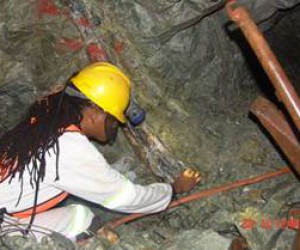Establishing whether the recent earthquake in South Africa's North West province was purely mining induced, or caused by natural tectonic shifts in the earth's crust, is not a simple matter, experts said during a recent panel discussion hosted by the Council for Scientific and Industrial Research (CSIR) in Pretoria.
It is also possible, they said, that stresses caused by mining triggered a natural event deeper down. This why seismic data always had to be carefully analysed after such events.
The earthquake, measuring a magnitude of 5.5 on the South African local magnitude scale, occurred just before lunchtime on 5 August with its epicentre near Orkney, a mining town in the Klerksdorp district. One person died when a wall collapsed, several miners were injured, and there was some structural damage to buildings.
Within minutes of the event, the United States Geological Survey (USGS) reported the location and magnitude of the event on its website. It also listed a depth of 10 kilometres.
However, as the CSIR's Professor Ray Durrheim noted, the "technical terms" page on the USGS website states that a default depth of five or 10 kilometres is often used in mid-continental regions when the depth is difficult to estimate. Not having read this page, some local experts prematurely concluded that the earthquake was a natural event and not mining-related, as mining activity in the region takes place up to depths of 3.5 kilometres below the surface.
Three days later, the US data was corrected to state a depth of 4.1 kilometres, indicating that it could indeed have been mining related.
According to Professor Andrzej Kijko, director of the Natural Hazards Centre of the University of Pretoria, the maximum magnitude of mining-induced quakes - those entirely caused by human activity - is approximately 3.5. These happen when rock layers near mine workings shift.
"We have, however, been mining for more than 80 years in Klerksdorp, creating stresses which can activate a pre-existing geological fault that lies much deeper," Kijko said. "This can then trigger a natural earthquake."
According to both Kijko and Durrheim, the fact that the tremors were felt so far from the epicentre, even in Durban and Cape Town, indicated that it was a low-frequency event, more typical of movements near an old fault in the earth's crust, rather than the brittle mining rock being displaced.
Professor Herbert Uzoegbo, a structural engineer from the University of the Witwatersrand, who specialises in the response of buildings to seismic events, supported the view that the earthquake might have been a natural earthquake triggered by mining. He based this on the fact that there were higher vibrations in tall buildings than in lower ones, also indicative of low-frequency events.
Uzoegbo added that building codes, especially in South Africa's mining areas, might need to be refined and better enforced. He said he had seen structural damage due to poor workmanship and design, including buckled and collapsed walls, cracks and the shifting of a house on its foundations.
One example of particularly dangerous building design, he said, was the parallel placement of several walls in one structure, increasing the risk of a domino-type collapse if an earthquake's shock were to hit the building from the wrong side.
In 2006, Durrheim and his colleagues presented a report to the Department of Minerals following a magnitude 5.3 earthquake which killed two miners in Stilfontein on 9 March 2005. The finding then was also that that earthquake was related to mining, and one of the recommendations was that seismic monitoring in the area needed to be improved.
In response to the report, the South African Council for Geoscience, which operates a national seismographic network involving the registering and mapping of all seismic events throughout the country, established three additional networks focusing on the country's mining regions.
The CSIR has also been collaborating with Japanese experts to measure seismic activity in South African mines, as part of a five-year-programme aimed at mitigating risk and developing local skills.
According to Durrheim, South Africa's deep mines are like "earthquake laboratories", in which the Japanese experts with whom the CSIR is collaborating can learn a lot about earthquake physics, while supporting local experts with state-of-the-art technology transfer and training.
Japan is a world leader in earthquake research. The country directed renewed investment into this type of research after the devastating Kobe earthquake, which killed 6 434 people in the southern part of Hyõgo Prefecture in 1995.
While the Japanese researchers focus on the monitoring of natural faults activated by mining, the CSIR experts have placed sensors such as seismometers, tilt meters and strain gauges near mine openings to measure mining-induced seismic activity. They drill holes near faults in the rocks and place the sensors in there to get the best data.
"Ultimately our data informs the seismic zoning of the country, providing guidance on the construction of buildings such as homes, schools or factories, in regions prone to earthquakes," Durrheim said.
The experts agreed that it is not possible to predict the times or locations of future earthquakes, but the data show that they are likely to recur in mining regions, even after mining has stopped. This has already informed planning for disaster management structures in the country.






